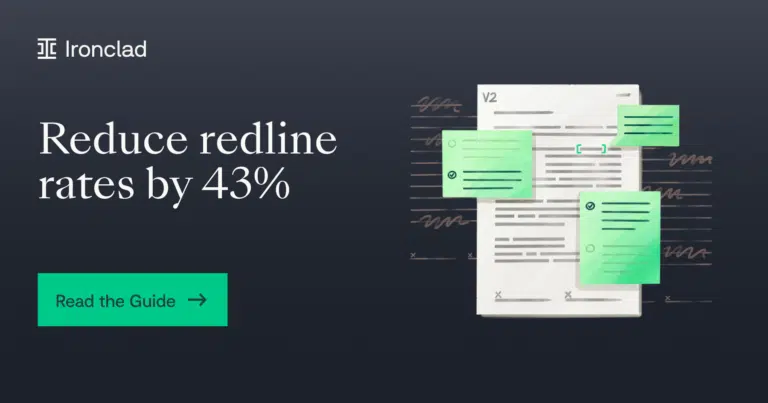Table of Contents
- Challenges with common contract negotiation methods
- 5 benefits of next-gen contract negotiation software
- Fast-track your contract negotiations
- Quiz: Measure Your Team’s Contract Maturity
Want more content like this? Sign up for our monthly newsletter.
Negotiation is a critical stage in the contract lifecycle. Before contracts moved online, it involved physical meetings and sending copies of contract documents back and forth via courier. Often, this could take months before parties arrived at terms favorable to all.
When the internet came along, contracts moved online. Sending digital copies of contracts via email replaced transporting physical copies via courier. However, businesses still faced the same challenge—slow-paced business contract negotiation.
The advent of contract lifecycle management (CLM) software in the last decade has changed all that. Businesses can now create, negotiate, sign, and manage contracts with greater ease. By using contract negotiation software, business contract negotiation can now move at a pace that doesn’t impede growth, making the process more collaborative and efficient.
Challenges with common contract negotiation methods
Few businesses are using courier-based methods of contract negotiation these days. However, using common communication tools like email and Microsoft Word can still pose many issues that slow the negotiation process down.
Difficulty in collaboration
In traditional business contract negotiation, there’s lots of communication between your organization and the counterparty via physical meetings, calls, or emails. Successful negotiation requires a high level of collaboration between external and internal stakeholders. For that to happen, these stakeholders need to communicate efficiently. Common communication mediums are not well suited for the level of collaboration that modern contract negotiation requires.
For instance, most companies use email as their primary method of communication during contract negotiation. It may look efficient at first glance, but as more and more input comes in from stakeholders during the negotiation process, an email conversation can quickly become a long, confusing thread that’s difficult to navigate.
Problems with tracking redlining
Redlining refers to the annotation and edits stakeholders in a contract negotiation make to the contract document. Previously, redlining was done on physical paper in colored ink. But now, many businesses use Microsoft Word for redlining contracts.
The issue with using Microsoft Word for redlining is that you or the counterparty may forget to track the changes you make to the contract document. When this happens, it’s difficult to find where changes have been made. This leads to unnecessary delays and wasted time.
Also, as redlining is done on digital documents sent via email attachments, there’s a high chance of stakeholders working with different versions of the contract at the same time.
5 benefits of next-gen contract negotiation software
If you’re still using email and digital documents for contract negotiation, your organization’s process needs to catch up with today’s fast-paced business world—especially if you deal with high-volume, high-risk contracts. You need a modern tool that addresses all the above issues, and this is what contract lifecycle management software does.
Digital contract management helps businesses streamline and fast-track their contracting process throughout all contract lifecycle stages. However, not all CLMs are the same. With today’s next-gen CLM software, your organization will have a powerful tool that can transform your contract negotiations from business blockers to enablers.
Next-gen CLM software offers the following benefits that can advance your business’s contract negotiation process:
1. Digital redlining
The traditional method of redlining was with a paper copy and a red pen. Party X drafts a contract copy and sends it to party Y. Y goes through the document, cancels the parts that are not favorable, and adds new things. Then Y sends it back to X, who either accepts or rejects Y’s edits.
This process can go on for weeks or even months until both parties arrive at a version they agree with. At this point, a clean copy is produced, and they’ll both sign.
Today, redlining is usually done by tracking changes in Microsoft Word. Documents are sent via emails, but there are still lots of problems associated with this.
Without a CLM, you may experience difficulty in tracking redlines and the possibility of stakeholders working with different versions of the contract. You may also spend valuable time restoring broken contract document formats. All of this will slow you down.
Using a CLM with a cloud-based redlining editor can eliminate these issues by:
- Giving every stakeholder access to the same document at all times
- Allowing the real-time tracking of all edits made to the document
- Storing digital contract documents in a central repository
- Maintaining document formats throughout the negotiation process
2. A single contract version
If you use emails for contract negotiation and redlining, you could have a situation where stakeholders are working with different versions of the contract. Using a CLM with a cloud-based redlining editor will give all stakeholders access to the current version of the contract document at all times. All redlines, comments, and approvals are done on that central document, with every action taken moving parties closer to their goal.
Contract negotiation software can help you keep track of all the changes made in a contract document as well as store all versions of the contract document. This way you can see how the contract evolved and who made each change.
3. Efficient digital collaboration
Often in contract negotiations, different departments have to work together to close a deal. For instance, a supply agreement may involve the procurement team at the forefront of the negotiation, finance to ensure that the numbers make business sense, and legal to vet and approve the contract. These teams’ primary interests vary, but they have to come together to achieve your organization’s overall business goal.
Communication tools like email don’t foster the level of collaboration your teams need to get the job done. They need tools that will enable them to work together efficiently, especially if your organization operates on a remote or hybrid work model.
Contracts often have complex requirements, and all departments involved have a part in getting them right.
With a CLM, stakeholders can see every interaction on a unified platform along with the context of every action taken by others. Actions taken can be further clarified by additional comments. This way, everyone gets carried along.
4. Activity feed
A next-gen CLM’s activity feed ensures all stakeholders have visibility into your contract negotiations. Everyone concerned can see what was done, when it was done, and who did it.
For instance, if anyone on your team needs to view the state of a sales agreement, there will be no need to sift through long email threads to do so. With a few clicks, you can see the current state of the negotiation—redlines, comments, feedback, and approvals—in real-time.
By showing the history of edits, reviews, feedback, and approval, a CLM can help your team streamline contract processes and ensure that negotiations are in compliance with internal policies and industry regulations.
Having this data can also help you understand your business’s overall contract process. You’ll be able to identify your weak links and any areas that need tightening up. For instance, you may discover that redlining is done fast, but getting approvals takes time. With that knowledge, you can speed up your contracting time by ensuring that the needed approvals are given faster.
5. Central repository for all your contracts
Clauses in contracts are usually written in specific ways. Your organization likely has a template for how you draft standard clauses. A CLM stores all of your contracts in a central database. This gives your team access to previous clauses and language while minimizing the need to draft contracts from scratch.
Having easy access to standard contracts can free up your legal team to carry out more value-added activities and empower other departments to negotiate some contracts on their own without involving the legal department. This way, your contracts negotiations can move faster and easier.
Fast-track your contract negotiations
Traditional communication and negotiation tools have proven inadequate in keeping up with today’s fast-paced business environment. It’s as though everything in business moves fast apart from contracts. Your organization can fast-track your contract negotiation process with Ironclad’s contract lifecycle management software. Learn about Ironclad’s pricing options.
Ironclad can help your organization through all the stages of your contract lifecycle—from contract creation to negotiation to execution.
Our platform is designed to help your teams to collaborate and negotiate contracts more efficiently. Your team can edit, comment on, and track changes on a contract document in a collaborative platform where all stakeholders are carried along. Innovative companies like Signifyd have used Ironclad to negotiate and review their contracts 85 times faster than before.
Explore how Ironclad can transform your business contracts and help you streamline your contract negotiation process by requesting a custom demo.
Quiz: Measure Your Team’s Contract Maturity
Ironclad is not a law firm, and this post does not constitute or contain legal advice. To evaluate the accuracy, sufficiency, or reliability of the ideas and guidance reflected here, or the applicability of these materials to your business, you should consult with a licensed attorney. Use of and access to any of the resources contained within Ironclad’s site do not create an attorney-client relationship between the user and Ironclad.
















